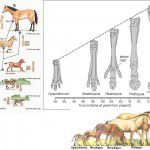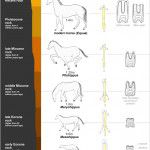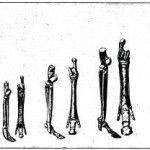Gaps In The Fossil Record
Opponents of evolution often point to gaps in the fossil record and suggest that this is evidence that evolution could not have occurred. Where are the intermediate species? It can be agreed without hesitation that there are not only gaps in the fossil records but enormous great voids! There are periods of millions of years which are sparsely represented or not represented at all in the fossil record. It is certain that there are thousands of organisms for which no fossil has ever been found and, in most cases, it is very likely that this situation will never be remedied. Whilst it is always useful to obtain more fossils and, indeed, they are still being found very frequently, the gaps do not represent any kind of difficulty for the evolutionary model.
How can this be claimed?
Fossils have been found and identified for what they are since the late 18th century and, as geology and palaeontology developed as sciences, and more and more people worked in the field, the number of finds had become enormous by the end of the 19th century. Through analysing the morphological resemblances and differences of these fossils, it was possible to come to some sort of understanding of the relationship of one with another. When it became clear that rocks were laid over many eons, and each layer contains its own specific community of fauna and flora, a picture of change arose.
Whilst each layer has different organisms from the previous and succeeding layers, it certainly looked like there were family resemblances and this cried out for some kind of explanation. Darwin’s theory placed all of the data from fossils and from living organisms into a coherent pattern, which fitted very well with the evidence, without being able to identify a precise mechanism. That mechanism was discovered once the basics of DNA were understood and now, with the help of computers, it has become possible to unravel the entire genome of many living species and, the fact that they are all genetically related has become entirely obvious. This is not to say that there is no room for debate and very passionate disagreement, but simply that the principle of evolution has been accepted by anyone who has looked closely at the evidence.
Why are there such big gaps in the fossil record?
This is simply because the process of fossilisation is extremely rare. An animal dying on an open plain will likely be eaten and its bones scattered. What is left will rot or crumble and nothing will be left for fossilisation. In a very short time there will be no evidence for its existence, apart from chemical residue, which will eventually dissipate too. Deep sea animals will sink to the bottom when they die and are unlikely ever to be located. An ordinary human burial preserves bodies a little better but, depending on such issues as soil type, temperature and moisture, most will decay within a few centuries and it is unlikely that many will become fossilised – a process which, in any case, takes many thousands of years.
The type of organism and the environment in which they lived are also important considerations. If you undertake an audit of the fossil record, you will find that animals with hard exoskeletons are extremely well represented, as are organisms that lived in the shallows around oceans, seas and lakes. The data is skewed. Hard shells obviously last longer than soft tissue and so are more likely to survive long enough for fossilisation to take place. Shallow water creatures will tend to sink into the sediment when they die, and are quickly covered, which provides an excellent environment for fossil formation. Disasters such as volcanic eruptions, landslides or the collapse of cliffs will bury fauna and flora and the conditions will sometimes be such that entire communities of animals can be found as fossils. This is particularly useful both in terms of numbers and also because it is possible to work out relationships and, perhaps, entire eco-systems. All of these circumstances are, however, the exception rather than the rule, and the many fossils that we have, even though they probably represent less than 1% of the species that ever lived, are a tribute the hard work and sheer bloody-mindedness of the fossil hunters.
So, although there may be substantial gaps in the record, we have more than enough to be able to deduce a pattern. Fossils of horses and their forebears, for example, are quite abundant, and we have examples stretching back many thousands of years. We can trace the process by which the five-toed foot in the early specimens developed, in succeeding species, to the present hoof arrangement. The hoof is nothing more than an adapted toe, and we can even find the remnants of the disused toes when we study the anatomy of the modern horse. We do not have a complete record of this process from beginning to end but, where there are gaps, we can look at the species before and after and deduce the kind of thing that must have occurred in between. (Click image below to enlarge and see more images)
The whale family is also a beautiful example of this process. As a mammal, and an air breathing organism, the hypothesis was that it must have originally evolved on land but, for a long time, there was very little evidence of this from fossils. Recent finds, however, have remedied this and we now have examples going back millions of years which tell almost the whole story. A modern whale no longer has back legs and the front legs have been adapted as fins. The remains of the back legs, however, can be seen in the skeletal structure of a modern whale and the front fins follow exactly the same skeletal pattern as a leg sharing exactly the same collection of articulated bones as the horse, human or bat.
The same kind of thing can be said of numerous animals for which we have fossils. We can trace a consistent pattern of evolution through the eons, and we are able to deduce from that what must have happened where we do find gaps. The fact that we can find the remnants of limbs and digits that have fallen into disuse is telling evidence of an evolutionary process and is, it can be contended, very problematic for any design hypothesis.
An enormous amount of hard work and serious thinking has gone into establishing evolution as the model which best fits the facts and, so far, no evidence has turned up which cannot be explained more than adequately by evolutionary processes.
Do Creationists provide a viable or even arguable alternative?
The answer to that seems to be a resounding no! It may be that there are other processes, so far undiscovered, that account for some aspects of the complexity and diversity of life that evolution cannot. If such a candidate hypothesis was identified, it would have to be looked into very carefully to establish whether it really did fit the evidence and, therefore, have anything to add. It would certainly open up some very interesting new areas of research and would likely yield a Nobel Prize or two! In the meantime, Creationists will identify an organism with attributes which cannot be immediately explained by evolutionary biologists or, indeed, by themselves, and assert that, no explanation forthcoming, it must have been the work of God.
Occasionally they will publicise findings, such as alleged human footprints next to those of dinosaurs, which would obviously cause a problem to evolutionary thinking if proven, but then ignore or distort counter-interpretations. Quite often they will identify a particular phenomenon and assert that evolutionists have no explanation for whatever it is, or have simply ignored it when, in fact, it is perfectly well understood and been covered in numerous peer-reviewed academic papers. Even if Creationists eventually come up with something that really could not be explained by evolution, simply asserting “therefore God did it” is an assertion and not an argument. If it can be dignified with the term “hypothesis” it, like any other hypothesis, would need to be backed up by argument and evidence which Creationists have signally failed to do. Until they are able to do this, their ideas can be confidently filed away



